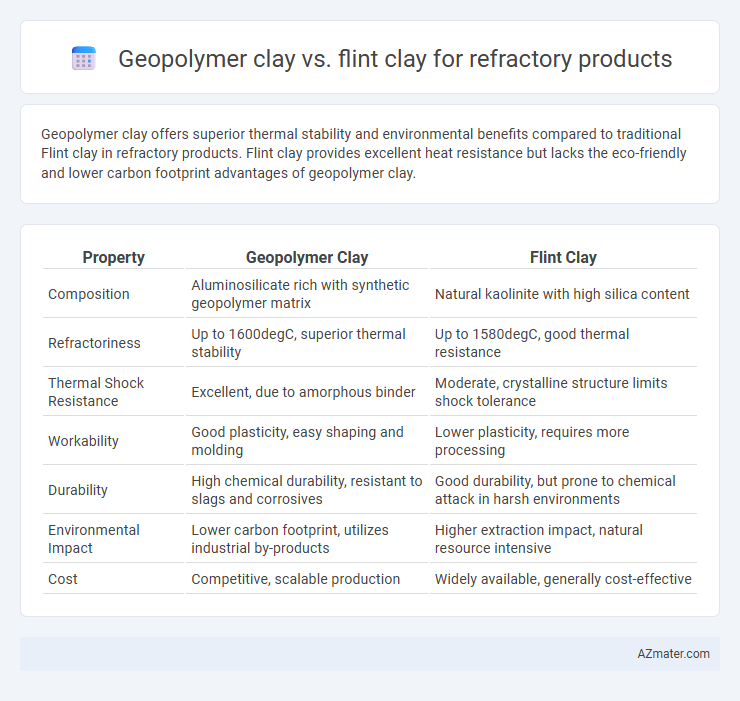Geopolymer clay offers superior thermal stability and environmental benefits compared to traditional Flint clay in refractory products. Flint clay provides excellent heat resistance but lacks the eco-friendly and lower carbon footprint advantages of geopolymer clay.
Table of Comparison
| Property | Geopolymer Clay | Flint Clay |
|---|---|---|
| Composition | Aluminosilicate rich with synthetic geopolymer matrix | Natural kaolinite with high silica content |
| Refractoriness | Up to 1600degC, superior thermal stability | Up to 1580degC, good thermal resistance |
| Thermal Shock Resistance | Excellent, due to amorphous binder | Moderate, crystalline structure limits shock tolerance |
| Workability | Good plasticity, easy shaping and molding | Lower plasticity, requires more processing |
| Durability | High chemical durability, resistant to slags and corrosives | Good durability, but prone to chemical attack in harsh environments |
| Environmental Impact | Lower carbon footprint, utilizes industrial by-products | Higher extraction impact, natural resource intensive |
| Cost | Competitive, scalable production | Widely available, generally cost-effective |
Introduction to Geopolymer Clay and Flint Clay
Geopolymer clay, derived from aluminosilicate materials, offers enhanced thermal stability and environmental benefits compared to traditional refractory materials. Flint clay, a naturally occurring kaolinitic clay, is prized for its high alumina content and excellent plasticity, making it a reliable choice for refractory applications. Both materials serve critical roles in refractory products, but their differing compositions influence performance characteristics such as thermal shock resistance and chemical durability.
Composition and Structure Differences
Geopolymer clay primarily consists of aluminosilicate materials activated by alkaline solutions, forming an amorphous to semi-crystalline three-dimensional network structure that provides high thermal stability and chemical resistance. Flint clay, composed mainly of kaolinite with a higher silica content, exhibits a more crystalline structure, characterized by strong refractory properties and slow vitrification at elevated temperatures. The distinct compositional difference lies in geopolymer clay's synthetic aluminosilicate matrix versus flint clay's natural kaolin-rich mineralogy, influencing their thermal behavior and mechanical strength in refractory applications.
Thermal Stability and Heat Resistance
Geopolymer clay exhibits superior thermal stability compared to Flint clay, maintaining structural integrity at temperatures exceeding 1200degC. Flint clay, while offering good heat resistance, tends to experience increased shrinkage and potential cracking under prolonged high-temperature exposure. The enhanced thermal properties of geopolymer clay make it more suitable for advanced refractory applications requiring consistent performance in extreme heat environments.
Mechanical Strength Comparison
Geopolymer clay demonstrates superior mechanical strength compared to Flint clay in refractory applications due to its enhanced bonding matrix and higher resistance to thermal shock. The geopolymer matrix forms stronger Si-O-Al bonds, resulting in better compressive strength and improved wear resistance under high-temperature conditions. In contrast, Flint clay typically exhibits lower mechanical strength and higher brittleness, limiting its performance in demanding refractory environments.
Chemical Resistance and Durability
Geopolymer clay exhibits superior chemical resistance compared to Flint clay, primarily due to its amorphous aluminosilicate structure that withstands acidic and alkaline environments effectively. Flint clay, rich in kaolinite and quartz, demonstrates good durability but is more susceptible to chemical degradation under aggressive conditions. The enhanced cross-linking in geopolymer matrices provides greater mechanical stability, contributing to longer service life in refractory applications exposed to harsh chemical environments.
Environmental Impact and Sustainability
Geopolymer clay offers a significantly lower carbon footprint than Flint clay due to its use of industrial by-products like fly ash or metakaolin, reducing reliance on energy-intensive raw materials and minimizing CO2 emissions. Flint clay, traditionally used in refractory products, requires extensive mining and high-temperature processing, leading to greater environmental degradation and higher energy consumption. The sustainable nature of geopolymer clay supports circular economy principles by utilizing waste materials and lowering environmental impact throughout the product lifecycle.
Manufacturing Process Variations
Geopolymer clay refractory products utilize an alkali-activated aluminosilicate binder system, enabling low-temperature curing and reduced energy consumption compared to traditional Flint clay, which relies on high-temperature sintering to achieve strength and thermal stability. The manufacturing process for geopolymer clay involves mixing metakaolin or fly ash with alkaline activators, followed by molding and ambient or low-temperature curing, whereas Flint clay requires mining, shaping, drying, and firing at temperatures above 1200degC. These process variations impact production cycle time, energy costs, and environmental footprint, making geopolymer clays more sustainable and potentially faster to produce for refractory applications.
Cost Efficiency and Availability
Geopolymer clay offers significant cost efficiency over Flint clay due to lower raw material expenses and less energy-intensive processing, making it a budget-friendly option for refractory products. Geopolymer clay sources are widely available and often derived from industrial by-products, ensuring consistent supply and reducing dependency on geographically limited Flint clay deposits. Flint clay, while traditional and high in alumina, tends to have higher extraction and transportation costs, impacting overall availability and pricing for refractory manufacturing.
Typical Applications in Refractory Products
Geopolymer clay excels in high-temperature resistant refractory linings for furnaces and boilers, offering superior thermal stability and chemical resistance compared to traditional ceramics. Flint clay is commonly utilized in firebricks, insulating castables, and kiln furniture where cost-effective durability and mechanical strength are essential. Both materials find applications in steelmaking, cement production, and glass manufacturing industries due to their refractoriness and structural integrity under extreme conditions.
Future Trends and Innovations in Refractory Clays
Geopolymer clay offers enhanced environmental sustainability and superior thermal stability compared to traditional Flint clay, driving increased adoption in refractory applications. Innovations in nanotechnology and additive manufacturing are enabling the development of geopolymer-based refractory materials with improved mechanical strength and thermal shock resistance. Future trends emphasize eco-friendly processes and the integration of smart sensors within geopolymer refractories to monitor and optimize performance in high-temperature industrial environments.

Infographic: Geopolymer clay vs Flint clay for Refractory product
 azmater.com
azmater.com